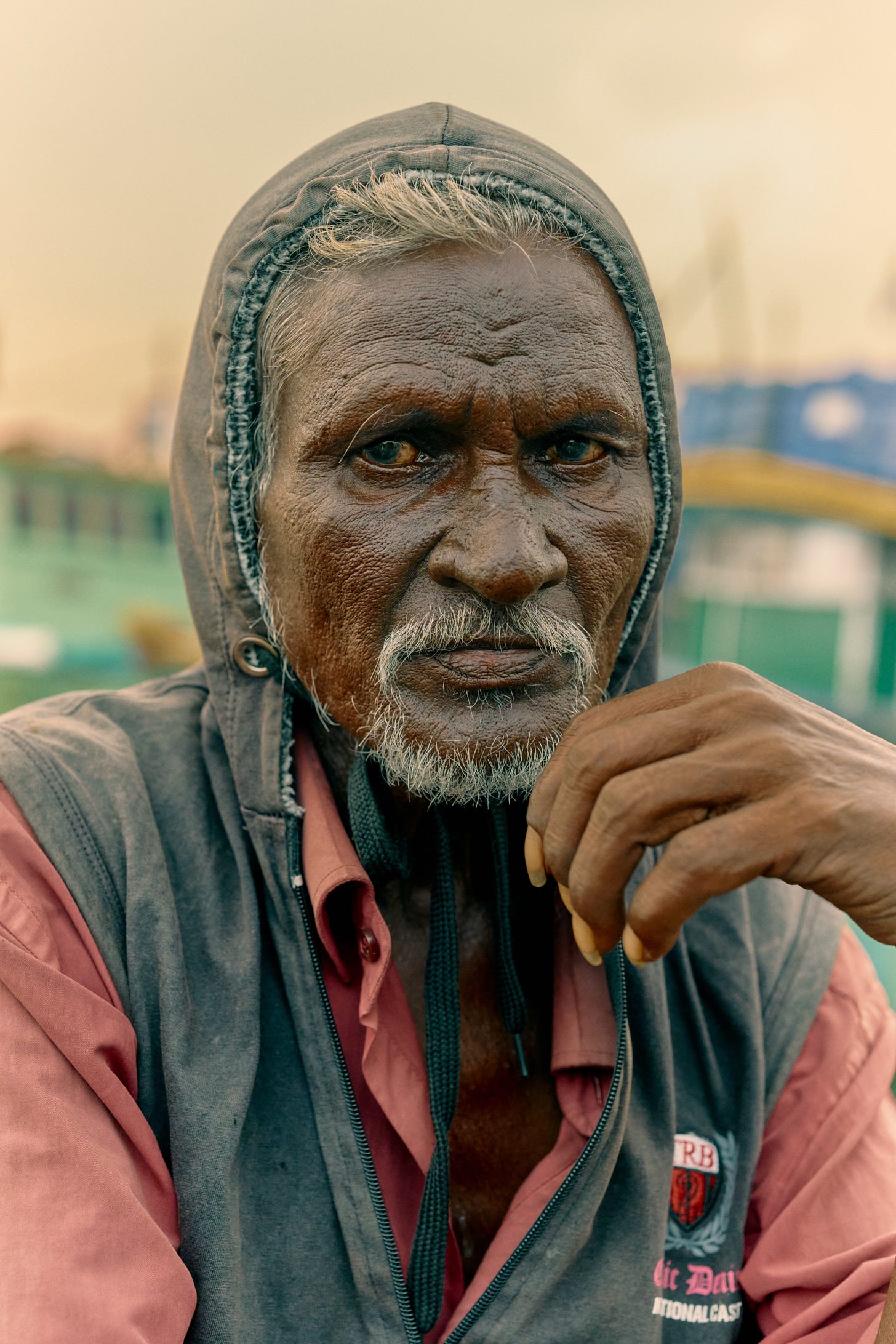Don't Be So Holy With ISO
How the cult of base ISO can hold our photography back
Photographers are often taught to avoid high ISO settings. We’re told to chase the cleanest file, the sharpest detail, and almost fear ISOs north of 800. I think a lot of this is bullsh*t, and we should push back on this narrative.
A low ISO is necessary for select environments (think commercial) but in most places, ISO isn’t the enemy. It’s a tool. And if we use it with purpose, we can expand our ability to create a compelling story.
The Details
This image was taken during an early morning walk at the Kasimedu fish market in Chennai. I had two Leica SL3-S cameras with me, and the one that captured this portrait was paired with the SL APO 50mm F2.0 lens.
With this lens, I know that if I lock focus on a subject’s eyes at F4.0, everything from the tip of their nose to their cheekbones will be in focus. That’s why I typically shoot my environmental portraits at this aperture when using an SL camera.
I’ll aim for a minimum shutter speed of 1/250, but given how dynamic this environment is—and how quickly expressions change as people react to the camera—I locked my shutter at 1/500 to reduce the risk of blur.
I entered this space with portraits in mind and as a result, shutter speed and aperture take priority over ISO. So I set a maximum ISO of 6400 and let the camera meter primarily for the centre of the frame. In this instance, the ISO landed at 3200. That’s high, sure, but it’s not something most people will notice—or care about—when they see the final image.
The Chase for Base
There are several reasons photographers aim for the lowest possible ISO. In no particular order, here are the main benefits:
Cleaner images with minimal noise
Maximum dynamic range for highlights and shadows
Rich, nuanced colour and tonal depth
Greater flexibility in post-production
These advantages matter, especially for commercial and editorial work. But here’s what I want to emphasize this week: we shouldn’t let them blindly dictate our overall approach. Modern cameras handle high ISO far better than they used to. That gives us room to be creative without being boxed in by old habits.
Below, you’ll find six situations where I will let my ISO float and why you might want to as well.
Low Light Photography
The obvious perk of higher ISO is shooting in low light. Dawn, dusk, even late nights—modern sensors can now produce usable, even beautiful, images in conditions that would’ve been impossible just a decade or two ago.
Faster Shutter Speeds
Take today’s example: I could’ve shot at 1/60 and kept ISO at 400. But would I risk it in a fast-moving moment? Nah.
For me, the marginal gain in technical performance did not outweigh the benefits of being more present in the moment. A higher ISO gives us access to faster shutter speeds, letting us shoot quicker and more instinctively when the scene is in motion.
Smaller Apertures, More Depth
Higher ISO also frees us to stop down our aperture for more depth of field focus. This is especially useful with wide-angle lenses where we want to share more of the story from a scene.
Less Gear, Faster Workflow
Bumping ISO often means leaving our tripod behind. That makes for a lighter, faster, more responsive workflow. While some die-hard tripod users may disagree, I’d rather stay nimble and adaptable than haul extra gear on every photo walk.
Embracing Grain
At high ISO levels—especially when using vintage glass—the resulting grain can enhance our image. Texture, imperfection, and mood can all serve the story. Let the story lead. If it calls for grain, embrace it.
Getting The Shot
When I’m shooting a magazine, a storefront image, or delivering video, I’ll lock ISO because the situation demands it. But outside those scenarios, I prioritize presence over technical perfection. The story comes first, and I’d rather get the shot than not.
Every environment is unique, but more often than not, I let my ISO float. That flexibility gives me more room to let the story shape the shot. And I believe this approach best serves most environments.
Streets of India: North & South Workshop
It’s official, I’m hosting my first workshop in India and I’m designing it to be the ultimate street photography experience. What does that mean? It means I’m curating a one-of-a-kind journey that you won’t find anywhere else—an experience rooted in creativity, expertise, and adventure.
Here’s what’s included:
Three cities in 10 days — A fast-paced, immersive experience
Unique shooting opportunities — A carefully curated selection of scenes
Key logistics covered — Hotels, drivers, and inter-city flights, all taken care of
Multiple instructors — Gain insights from diverse perspectives
Guest lectures — Learn from a variety of industry experts
Limited to 8-10 guests — A small group for personalized learning
This workshop will take place from September 20th through the 29th this year. From the moment you land in India, you’ll be guided through a street photography adventure like no other. My fellow instructors and I will be there every step of the way to share our knowledge and techniques with you.
A few seats are still available so visit the link below to learn more.



